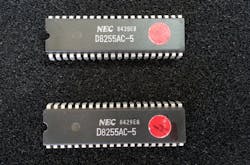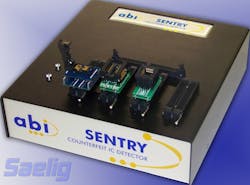This article is part of TechXchange: Chip Shortages and Counterfeits
What you’ll learn:
- Why counterfeit integrated circuits are a problem.
- Types of, and methods behind, counterfeits.
- How you can protect yourself from counterfeit parts.
With the current worldwide chip shortage, manufacturers are desperately scrambling to keep their production lines going for electronics goods and automobiles. One solution many companies are turning to is the so-called “gray market”—non-authorized suppliers of obsolete and excess component stocks. While this can be a quick fix, it presents a problem that’s challenging to detect and eliminate: counterfeit ICs.
For instance, a Massachusetts man was sentenced a few years ago to 37 months in prison for importing thousands of counterfeit integrated circuits from China and Hong Kong, which were resold to U.S. Navy contractors and installed in nuclear submarines. He also sold components to hundreds of other independent distributors and brokers in the U.S. and Europe, and the fake ICs reached even more government contractors and commercial manufacturers.
The counterfeit ICs were marked as originating from over 30 different IC suppliers. This case, with an unknown number of similar ones, shows that the presence of counterfeit components in the supply chain is a very significant and growing issue.
ICs aren’t hard to fake, unlike banknotes. Making “lookalike” parts that resemble real ones takes very little skill. It simply requires finding cheap parts in the same format of package and merely painting new marks on them. This problem has arisen due to the high value of some electronics products, and this issue makes the whole manufacturing chain from assembly house to end-user vulnerable. The number of companies that have been fooled by batches of fake devices is incalculable.
Counterfeiting semiconductors has been a rapidly increasing trend, impacting a wide variety of electronics systems used by a wide gamut of involved parties—consumers, businesses, and military customers. The detection of counterfeit components has become an increasingly important priority for electronics manufacturers and component suppliers worldwide.
The Semiconductor Industry Association has estimated that counterfeit electronic parts have cost manufacturers more than $7.5 billion. Not only are companies suffering losses, delays and inconvenience, their reputations are being sullied because of the presence of counterfeit ICs in the market.
What Are Counterfeit Components?
Counterfeiters use several methods to produce their fake goods:
- Empty packages marked to resemble actual ICs.
- Cheap ICs re-marked to resemble more expensive ICs.
- ICs with similar but poorer specs re-marked to resemble better spec, more expensive ICs.
- ICs salvaged from circuit boards.
The most prevalent counterfeiting technique is selling re-badged products. It’s a simple matter to remove the existing mark from a chip package and put on a new logo and part number, or a different brand or a different speed—and then sell the semiconductor to an unsuspecting buyer who has no way of making sure that the product is “real.” Sometimes the chip is merely an empty package with no die inside (Fig. 1).
It’s true that the finished system would fail before it left the factory. Nonetheless, it still requires expensive investigation and rework, with no replacement part available to replace the bad one, causing the dreaded “Line Down!” But the failure of fake borderline ICs may not occur until the system is in the field, and field repairs can cost 10X as much to fix as those caught before they leave the factory.
Counterfeiting also can occur with chips gleaned from discarded scrap boards. They can be re-marked with a different manufacturer’s logo, inserted into the supply chain, and sold to innocent buyers, who naturally assume that the products are genuine.
Usually, it’s impossible to identify counterfeit components until they’re fitted on a PCB, when the first tests are made on the final product. Failure requires the costly identification of the bad components and then lifting them from all boards in the production line. Complete batches of finished products may need to be recalled to the factory, directly hurting a company’s bottom line.
Technical measures to solve this problem have previously included visual inspection of devices for marking errors, which needs a trained eye for all possible variations in marking. Electronically testing or x-raying every incoming batch is another technique.
Another destructive method is to use a complex decapsulation method to visually inspect the IC die with a microscope, immediately losing revenue due to the component’s destruction (Fig. 2). Not only is this expensive and time-consuming, but it requires complex training, skilled operators, and expensive equipment.
Screening
Some distributors have advertised their screening services for verifying components, with a turnaround time of “as little as two days.” That’s unacceptable in many cases. These companies offer techniques such as x-ray, x-ray fluorescence analysis (XRF), decapsulation, heated solvent testing, visual inspection, and solderability testing, resulting in detailed reports—when all that was required was a determination of “is it a good part?” In reality, this approach is only viable for military or large-volume production runs.
One method is to perform a functional test on a sample of the ICs; an example is logic I/O conforming to a truth table. This will detect gross problems, such as an incorrect logical function, or no function at all. However, they will miss the subtle “out of tolerance” issues—tell-tale signs that a component is counterfeit. With older-technology IC families, different speed variants are often available. Conventional testing equipment with this level of speed test capability is extremely expensive.
Addressing the Issue
A tool that can verify the identity of received ICs quickly and economically, using a statistically significant procedure, needs to be suitable for all devices and packages, should be easy to operate, and must give fast “good/suspect/fail” results. An example of such a solution is the ABI Sentry Counterfeit IC Detector, a PC-driven product that can check the validity of parts in seconds.
Simple to use, the tool enables any receiving department to operate the equipment. The analysis takes place in the background, and the operator only sees a simple “Good Device,” “Blank Device,” or “Fail Device” message, with the option to produce a detailed report to send to the supplier.
The ABI Sentry is a benchtop device that uses an advanced form of V-I testing on any IC chip to determine its electrical characteristics or “signature” (Fig. 3). V-I testing applies a voltage waveform between two IC pins and measures how the current drawn changes as the applied voltage varies. This response is directly related to the device characteristic, its internal structure, and manufacturing processes.
Running every possible pin-to-pin combination on the IC under investigation, the device provides a great deal of insight into the IC, more than simple systems that are restricted to testing between pins and ground. The Sentry’s Matrix V-I Test can reveal differences between devices with different functionality but similar technology. A re-labeled fake chip with a similar I/O pinout would be detected by this test.
Establishing the Signature
The V-I characteristics captured by Sentry are called PinPrints, which represent the unique signature for a device. Sentry is employed first to test a known-good device and obtain its “gold standard” signature. The subsequent signatures of incoming, unknown chips are compared with the known-good version to check for discrepancies.
Small variations are likely to indicate that the chips are from different manufacturers, or possibly different batches from the same manufacturer. Larger differences, however, suggest that the chips are faulty or counterfeit. Sentry can be customized for each IC type by setting tolerances that define the point at which a tested device is deemed “bad.”
If no reference devices are available, two alternatives could be used. Reference data can be exported from other users’ machines or libraries and imported into the Sentry’s database. Alternatively (and not quite as good), testing can be done across the batch. If there’s any variance, then the whole batch becomes suspect and should be rejected. A package with no internal die is easily detected—all pins will show the straight line “null response” of an open circuit.
Sentry contains a set of ZIF sockets accepting adapters for DIP, SOIC, BGA, SSOP, as well as discrete components. The system uses a comparative technique to rapidly analyze and learn new components, and then test the unknown parts. A known-good component is locked into the ZIF socket while a test pattern is applied across all of its pins. The component’s response to this test pattern is automatically measured and stored as a benchmark.
A combination of Sentry’s electronic parameter settings (voltage, frequency, source resistance and waveform) generate the “signature” for each pin of the IC being checked. It then compares the unique electrical characteristics of known components and with suspect components. Testing between every possible pin combination is included, maximizing the chances of capturing internal fault conditions. Sentry can quickly detect missing or incorrect dies, lack of bond wires, inaccurate pinouts, and pin impedance variations. Simple pass or fail results are returned after testing, offering a high level of confidence in the authenticity of components.
As parts become increasingly complex, 100% testing becomes burdensome, but testing one or two pieces out of, say, 200 pieces is manageable. Experience has shown that variations arising from a suspect shipment will reveal themselves well before such a test is complete. Nevertheless, if 100% non-destructive testing is required, using a Sentry Counterfeit IC Detector is a workable solution.
Sentry is able to identify parts that have a different internal structure, or no structure at all, and even components originating from a different manufacturer. Controlled via USB using the PC software provided, Sentry’s stored device library can be built up by adding specific known-good devices.
Each device can have documents associated with it in the software, such as photos of device markings, datasheets, and other documents to further help in confirming the integrity of a device. Detailed reports are able to be saved to provide quality-control traceability. Sentry can protect production facilities from the infiltration of counterfeit devices, identifying bad parts before they cause problems.
Sentry Hardware
Sentry contains all of the hardware required to analyze the electrical characteristics of ICs with up to 256 pins (Fig. 4). In addition, 256-pin+ devices can be tested by rotating the device (BGA, QFP) to allow all pins to be learned and compared.
Sentry comes with four 48-pin dual-inline (DIL) zero-insertion-force (ZIF) sockets. These can be used directly for older DIP components, but also can be used to accommodate a variety of additional socket adapters available for different package types. The socket adapter may contain multiple IC sockets if required, to allow testing several ICs at the same time or comparing one IC with another. An expansion connector allows custom socket adapters with up to 256 pins to be attached.
ABI Sentry is housed in a sturdy metal box (10.6 × 10 × 3.6 in.) and weighs 8 lbs. It can receive separate interchangeable adapters for accepting various IC packages under test. With its large range of optional adapters, Sentry can accommodate most types of IC packages, including DIP, SOIC, PLCC, QFP, and even BGA. For simplicity of operation, Sentry has no display or keypad, but is entirely controlled by a PC via USB using ABI’s custom-designed free software.
Conclusion
The ABI Sentry is an example of a practical solution for solving the counterfeit IC issue, using its rapidly learned dedicated library of component data to cross-check each part tested. With lead-time issues making ICs harder to acquire for meeting aggressive manufacturing schedules, identifying any parts that aren’t “real” before they enter production can potentially save every manufacturer a great deal of time and money. It also helps build the intangible but hard-to-retrieve trait of brand reputation.
Read more articles in TechXchange: Chip Shortages and Counterfeits
About the Author
Alan Lowne
CEO, Saelig
Alan Lowne is anlectronics engineer and CEO of Saelig Co. Inc., an industrial electronics importing business he started after a long career at Kodak and Johnson & Johnson. He trained as an electronics engineer at Southampton University (UK) and Brunel University (UK) and holds six U.S. patents in optoelectronics.




